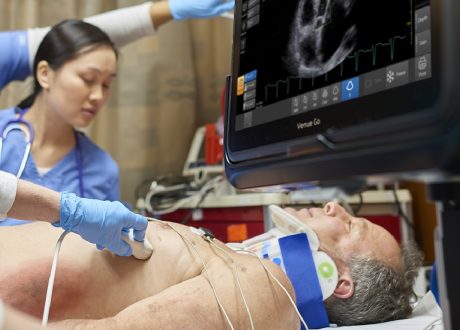Amir Qaseem, MD, PhD, MHA; Itziar Etxeandia-Ikobaltzeta, PharmD, PhD; Reem A. Mustafa, MD, MPH, PhD;Devan Kansagara, MD, MCR; Nick Fitterman, MD; and Timothy J. Wilt, MD, MPH; for the Clinical Guidelines Committeeof the American College of Physicians*
 The American College of Physicians (ACP)developed this guideline to provide clinical recommenda-tions on the appropriate use of point-of-care ultrasonogra-phy (POCUS) in patients with acute dyspnea in emergencydepartment (ED) or inpatient settings to improve the diag-nostic, treatment, and health outcomes of those with sus-pected congestive heart failure, pneumonia, pulmonaryembolism, pleural effusion, or pneumothorax.
Methods:
 The ACP Clinical Guidelines Committee based thisguideline on a systematic review on the bene
ts, harms, anddiagnostic test accuracy of POCUS; patient values and prefer-ences; and costs of POCUS. The systematic review evaluatedhealth outcomes, diagnostic timeliness, treatment decisions,and test accuracy. The critical health, diagnostic, and treatmentoutcomes evaluated were in-hospital mortality, time to diagno-sis, and time to treatment. The important outcomes evaluatedwere intensive care unit admissions, correctness of diagnosis,disease-speci
c outcomes, hospital readmissions, length of hospital stay, and quality of life. The critical test accuracy out-comes included false-positive results for suspected pneumonia,pneumothorax, and pulmonary embolism and false-negativeresults for suspected congestive heart failure, pneumonia,pneumothorax, and pulmonary embolism. Important test accu-racy outcomes included false-positive results for suspectedcongestive heart failure and false-negative and false-positiveresults for suspected pleural effusion. This guideline was devel-oped using the GRADE (Grading of RecommendationsAssessment, Development and Evaluation) method.
Target Audience and Patient Population:
 The target au-dience is all clinicians, and the target patient population isadult patients with acute dyspnea in ED or inpatient settings.
Recommendation:
 ACP suggests that clinicians may use point-of-care ultrasonography in addition to the standarddiagnostic pathway when there is diagnostic uncertainty in patients with acute dyspnea in emergency department or inpatient settings (conditional recommendation; low-certainty evidence).
 Ann Intern Med.
 doi:10.7326/M20-7844
For author, article, and disclosure information, see end of text.This article was published at Annals.org on 27 April 2021









